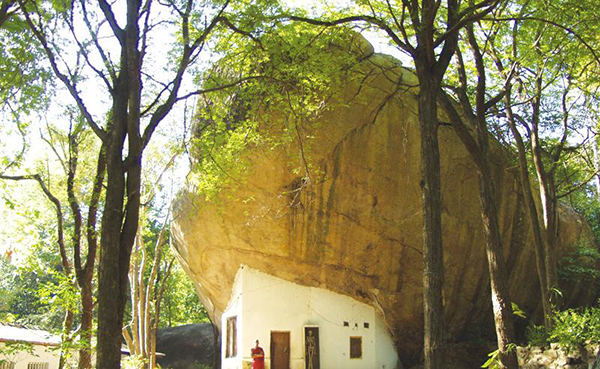
Source:Sundayobserver
It had been our cherished dream to visit Dambana, the ancestral Adivasi village. We had spent years looking forward to it and finally it took months to plan the trip. Dambana was not a disappointment, but there was something different for us in the trip as well.
 Long before we reached Dambana, our minds were made up on what we wanted to do there – to document the daily life of the fast-vanishing indigenous people of our land. However, as we drove along the A-26 Mahiyangana-Padiyatalawa Road on one sunny morning, we were struck with the idea of visiting the ancient forest hermitage called Mawaragala, which lies on the slope of a rocky mountain in Dambana. There we were at the Mawaragala forest hermitage, 15 kilometres away from Mahiyangana, taking a turn just before the ancestral Adivasi village, Kotabakiniya.
Long before we reached Dambana, our minds were made up on what we wanted to do there – to document the daily life of the fast-vanishing indigenous people of our land. However, as we drove along the A-26 Mahiyangana-Padiyatalawa Road on one sunny morning, we were struck with the idea of visiting the ancient forest hermitage called Mawaragala, which lies on the slope of a rocky mountain in Dambana. There we were at the Mawaragala forest hermitage, 15 kilometres away from Mahiyangana, taking a turn just before the ancestral Adivasi village, Kotabakiniya.
A neatly kept pathway led us on a steady climb through the forest and rock boulders, the greenery all around providing a salubrious climate. It was a hot sunny morning, yet the ample tree shade protected us from the heat. The rocky landscape and the serene undisturbed environment seemed ideal for meditation. Those pathways were leading to kuti or bhikkhu’s abodes built in drip-ledge caves, where bhikkhus stay and meditate.
Drip-ledge caves
The Mawaragala hermitage was on top of a rocky mountain in a 500-acre forest. The drip-ledge caves with brahmi inscriptions had been built on the slope of the mountain. The chief bhikkhu of the hermitage has taken steps to protect the flora, while growing more trees in the area surrounding the hermitage.
We met a young resident bhikkhu named Kewle Samitawansa who took us to every nook and corner of the hermitage, while explaining the history of the site to me. First, he took us to the chief bhikkhu’s kuti and met the chief bhikkhu at his spacious kuti.

According to the chief bhikkhu, the hermitage’s history goes back to the King Walagambahu’s reign. He said that according to legend, an erudite bhikkhu called Arahat Maliyadeva and 60 other bhikkhus lived in the place during that time. Later, those rock caves had been used by Wanniyale-Atto of Dambana for dwelling.
There are enough kuti for at least 25 bhikkhus at the hermitage. These have been built in the drip-ledge caves in the forest reserve, away from the entrance to the hermitage, where the shrine room is located. A building has been built for the devotees to prepare alms for the bhikkhus. It is only between 11.30 am and 1 pm that visitors are permitted to go to the areas where the kutis are located. We witnessed the mid-day dana (alms giving) during our stay at the hermitage. Over 20 bhikkhus were present.
At around 10 am, one Samanera rang the bell to alert the bhikkhus in distance kutis, informing them to gather near the main entrance. From there, they walked to the danasalawa (alms hall). It was a rare sight, to see them walking silently down the pathway on pindapatha, in keeping with the tradition dating back to the days of the Buddha.
Partaking of alms

They came in a single file, one after other, each carrying an alms bowl. Once their feet were washed, they moved as one and patiently let the devotees serve the alms, which they prepared in the morning, into their begging bowls. Then they retired into the alms hall a little further in the forest and sat down to eat the food they had been offered.
The Bawanagala was the most interesting place in the hermitage. The rock surface offered a naturally laid floor area, which was about 25 square feet. Legend has it that it was where Arahat Maliyadeva and the 60 other bhikkhus meditated.
The holes on the rock surface, it was learnt, were covered with a roof to offer shelter to the bhikkhus from the rain and the sun. Foreign bhikkhus also visit the hermitage to practise meditation. The hermitage has a pirivena (school for novice samaneras) for those who come from areas, such as Padiyatalawa, Maha Oya and other remote areas.
The Mawaragala hermitage was a gift of nature where silence and serenity prevail – the ideal place for meditating bhikkhus who struggle to seek emancipation. The chief bhikkhu of the hermitage said the place is open to nature lovers – the best medicine for a stressed mind.






